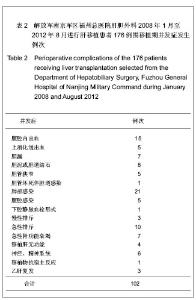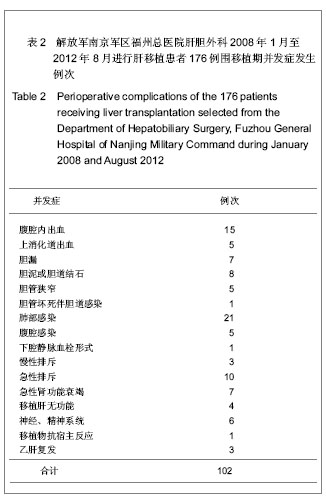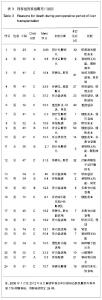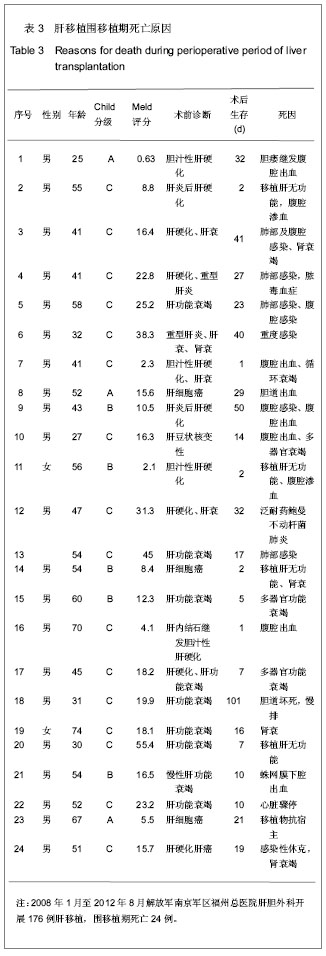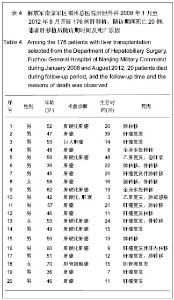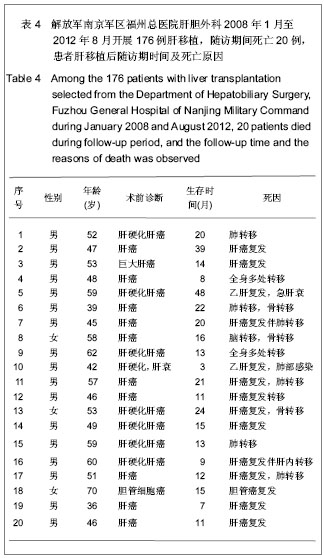| [1] State Council of the People's Republic of China. Administrative Regulations on Medical Institution.1994-09-01. 中华人民共和国国务院.医疗机构管理条例.1994-09-01. [2] Pugh RN,Murray-Lyon IM,Dawson JL,et al.Transection of the oesophagus for bleeding oesophageal varices. Br J Surg. 1973; 60: 646-649. [3] Malinehoe M,Kamath PS,Gordon FD,et al.A model to prediet poor survival in patients undergoing transjugular intrahepatic portosystemic shunts.Hepatology.2000:31;864-871.[4] Klyachkin ML,Dhillon JS,Kaveh SJ,et a1. Current management of severe intraabdominal infection.Curr Surg.1998,55:39-45.[5] Lv Y. Beijing: Science Press,2008:135-142.吕毅.临床诊疗手册-肝移植手册[M].北京:科学出版社,2008: 135-142.[6] He XS,Jv WQ. Linchuang Waike Zazhi.2006;14(6):331-332.何晓顺,鞠卫强.肝移植术后常见并发症的处理[J].临床外科杂志,2006,14(6):331-332.[7] Yan LN,Li B,Lu SC,et al. Linchuang Waike Zazhi.2002; 10(6): 333-336.严律南,李波,卢实春,等.原位肝移植术后近期并发症的防治[J].临床外科杂志,2002,10(6):333-336.[8] Liu BQ,Cao CX,Liang XP,Zhongguo Dangdai Yixue Zazhi. 2012,22(26):106-108.刘宝琴,曹翠霞,梁香萍,等.肝脏移植术后初期腹腔出血的观察与护理[J].中国现代医学杂志,2012,22(26):106-108.[9] Zhang S,Zhou J,Tan YF,et al.Guangdong Yixue. 2012;33(6): 770-772.张胜,周杰,谭永法,等.肝移植术后腹腔大出血的相关因素分析[J].广东医学,2012,33(6):770-772.[10] Yi M,Zhu X,Zhang TL. Zhonghua Yiyuan Ganranxue Zazhi, 17(2):154-156.伊敏,朱曦,张同琳,肝移植术后肺部感染的临床分析[J].中华医院感染学杂志.2007,17(2):154-156[11] Shi J,Ding LM.Zhonghua Putong Waikexue Wenxian: Electronic Edition.2010;4 (5):450- 452.时军,丁利民.肝移植后肺部感染的因素分析及防治[J].中华普通外科学文献:电子版,2010,4 (5):450-452.[12] Cai ZS,Jiang Y, Lv LZ,et al. Linchuang Waike Zazhi. 2008; 16(12):808-809.蔡志仕,江艺,吕立志,等.肝移植围手术期的危险因素与术后肺部并发症的关系分析[J].临床外科杂志,2008,16(12):808-809.[13] Lv LZ,Cai QC,Jiang Y,et al.Zhonghua Gandan Waike Zazhi. 2011;16(12):808-809.吕立志,蔡秋程,江艺,等.原位肝移植逆灌注法对术后肺部并发症的影响[J].中华普通外科学文献:电子版,2011,5(1):3-5.[14] Thethy S,Thomson BN, Pleass H, et a1.Management of biliary tract complications after orthotopic liver transplantation.Clin Transplant.2004;18(6):647-653.[15] Huang WF,Zhang XL,Xie ZJ.Zhongguo Zuzhi Gongcheng Yanjiu. 2012,16(5):908-910.黄文峰,张小玲,谢志军,等.肝移植的研究进展及常见并发症处理[J].中国组织工程研究,2012,16(5):908-910.[16] Cameron AM, Busuttil RW.Ischemic-type biliary complications after orthotopic liver transplantation.Hepatobiliary Pancreat Dis Int.2005;4 (4): 495-501.[17] Patkowski W,Zieniewicz K,Skalski M,et al. Correlation between selected prognostic factors and postoperative course in liver transplant recipients.Transplant Proc.2009; 41(8):3091-3102.[18] Park JB,Kwon CH,Choi GS,et al.Prolonged cold ischemic time is a risk factor for biliary strictures in ductto-duct biliary reconstruction in living donor liver transplantation. Transplantation.2008;86(11):1536-1542.[19] Peng ZH,Wang SY.Waike Lilun yu Shijian.201116(4):352-353.彭志海,王书云.肝移植后胆管并发症的防治策略[J].外科理论与实践,2011,16(4):352-353.[20] Yang LM,Wang SY,Yan CW.Zhongguo Zuzhi Gongcheng Yanjiu yu Linchuang Kangfu.2011;15(5):823-824.杨丽敏,王守云,闫春伟,等.肝移植后慢性排异反应1例[J]. 中国组织工程研究与临床康复.2011,15(5):823-824.[21] Demetris AJ,Seaberg EC,Batts KP, et al.Chronic liver allograft rejection: a National Institute of Diabetes and Digestive and Kidney Diseases interinstitutional study analyzing the reliability of current criteria and proposal of an expanded definition. Am J Surg Pathol.1998:22:28-39.[22] Taylor AL,Gibbs P,Sudhindran S,et a1.Monitoring systemic donor lymphocyte macrochime rism to aid the diagnosis of graft graft versus-host disease after liver transplantation. Transplantation.2004;77(3):412.[23] Chen G,Dong JH.Zhonghua Putong Waike Zazhi. 2002, 17: 254-256.陈耿,董家鸿,肝移植术后急性肾功能衰竭的发生机理与对策[J],中华普通外科杂志.2002,17:254-256.[24] Chuang FR,Lin CC,Wang PH,et al.Acute renal failure after cadavefic related liver transplantation.Transplant proc.2004; 36:2328-2330.[25] Li QH,Guo XD,Zhang M,et al.Xiandai Shengwu Yixue Jingzhan. 2011;11(20):3906-3908.李庆虹,郭晓东,张敏,等.肝移植术后急性肾功能衰竭的相关因素的临床分析. 现代生物医学进展.2011,11(20):3906-3908.[26] Zhang WH,Jiang Y,Lv LZ,et al.Linchuang Waike Zazhi. 2007, 16(11):749-751.张文华,江艺,吕立志,等.乙肝相关性终末期肝病肝移植后乙肝复发的防治[J]. 临床外科杂志.2007,16(11):749-751.[27] Yang Y,Xie XY.Cai CJ,et al.Zhonghua Putong Waike Zazhi. 2001;16(12):716-718.杨扬,谢晓燕,蔡常洁,等.原位肝移植术后血管并发症的早期诊断8例报告[J].中华普通外科杂志,2001,16(12):716-718.[28] Sun HY,Cai J,Guan JQ,et al.Zhonghua Yizhi Zazhi:Dianziban. 2010;4(1):26-29.孙海云,蔡珺,关健强.等.肝移植后脑病围手术期危险因素分析[J/CD].中华移植杂志:电子版,2010,4(1):26-29.[29] Cai CJ, Lu MQ, An YL, et al. Nanfang Yike Daxue Xue bao. 2007;27 (6):849-851.蔡常洁,陆敏强,安玉玲,等.肝移植术后并发桥脑中央髓鞘溶解症的诊断与治疗[J].南方医科大学学报,2007,27(6):849-851.[30] Fukazawa K, Nishida S, Aguina L, et al.Central pontine myelinolysis( CPM) associated with tacrolimus (FK506) after liver transplantation.Ann Transplant.2011:16(3):139-142.[31] Schwartz RB,Bravo SM,Klufas RA,et al.Cyclosporine neurotoxicity and its relationship to hypertensive encephalopathy: CT and MR findings in 16 cases.Am J Roentgenol.1995;165(3):627-631.[32] Xu QX,Ding YT,Qiu YD,et al. Zhonghua Qiguan Yizhi Zazhi.2006;27(4):201-203.徐庆祥,丁义涛,仇毓东,等.肝移植术后神经系统并发症 28例分析[J].中华器官移植杂志,2006,27(4):201-203. |
